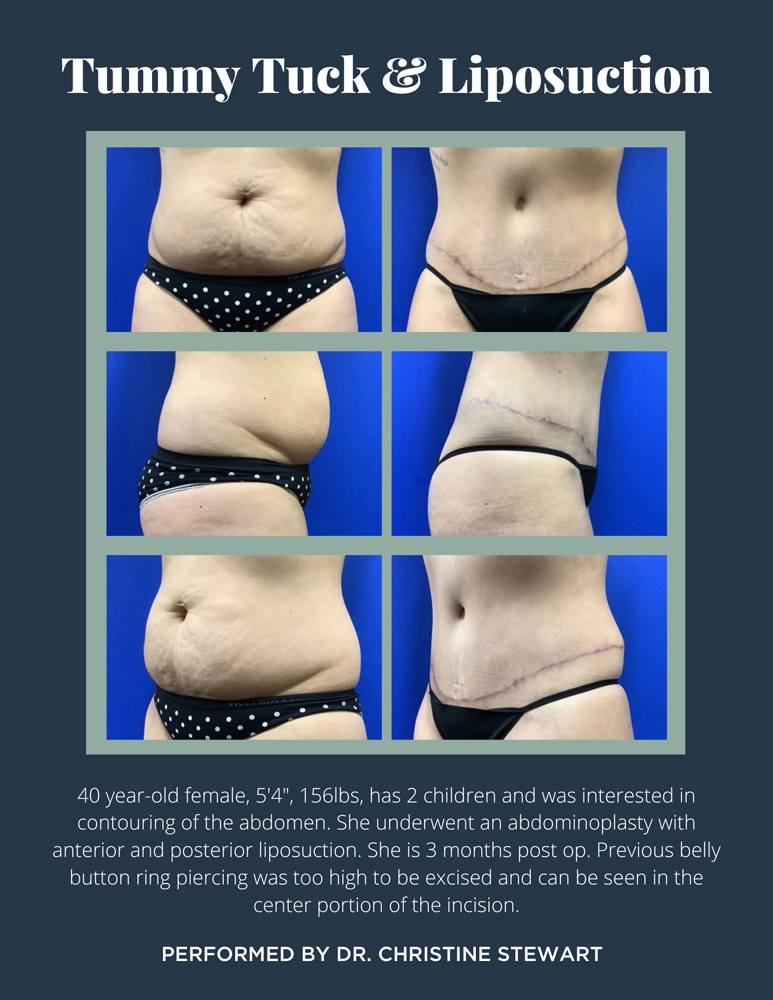Having a lean, toned midsection is a common aspiration for both women and men. When diet and exercise alone can’t achieve this goal, thousands of people turn to plastic surgery each year to improve the appearance of their waistline. Tummy tuck (abdominoplasty) surgery and liposuction are two of the most popular procedures to create a slimmer and smoother abdomen. But how can you tell which surgery will deliver the results you’re hoping for? Here are five key differences between tummy tuck surgery and liposuction to help you identify which procedure may help you makeover your midsection!
What Do Abdominoplasty Surgery and Liposuction Have in Common?
“Both tummy tuck and liposuction surgery are very effective procedures to improve the appearance of the abdomen,” says Dr. Christine Stewart, a board-certified plastic surgeon and partner at Edina Plastic Surgery. “They can both remove fat from the midsection, but that’s pretty much where the similarities end. Each surgery is unique in how they can improve the appearance of your waistline and the method they use to achieve it.”
5 Key Differences Between Liposuction Surgery and a Tummy Tuck
#1 – The Ideal Candidate
The best candidates for liposuction are healthy, non-smoking individuals close to their goal weight. They have stubborn pockets of subcutaneous fat, where the fat resides between muscle and skin, as opposed to visceral fat, where the layer of fat resides beneath the muscle and around the abdominal organs. It’s important to note that even though liposuction removes fat, it should not be viewed as a weight loss procedure and can only remove a certain amount of fat safely with each surgery.
“The ideal candidate for a tummy tuck is someone who is struggling with loose, sagging skin around their midsection,” explains Dr. Stewart. “This excess skin is common after dramatic weight loss or pregnancy. Tummy tuck surgery differs from liposuction because it removes skin and tightens abdominal muscles to firm and smooth the midsection. In contrast, liposuction seeks to remove fat volume to reshape the contours of the abdomen. That being said, many patients benefit from having BOTH surgeries to reach their aesthetic goals.”
#2 – How the Procedure Works
“The liposuction process typically begins with the administration of anesthesia,” says Dr. Stewart. “After that, a small incision will be made near the body areas treated. This could be one or multiple points of entry, but your surgeon will do their best to ensure that as few incisions are made as possible and that they are as hidden and discreet as they can be. Then, a small cannula will be inserted into the incisions and moved around to dislodge fat in the surrounding area. The tube has a suction tip at the end of it, which will pull the fat out of the body. The incisions are then closed, and you will begin your recovery.”
During a tummy tuck, an incision is generally made low on the abdomen, below the belly button. Excess skin and fat are removed, and any underlying muscle laxity (common after pregnancy) is tightened with sutures. The overlying skin is then trimmed and redraped to create a smoother, firmer-looking waistline.
“Every tummy tuck surgery requires a unique approach,” advises Dr. Stewart. “In addition to making micro-adjustments to your abdominoplasty depending on your anatomy, there are three typical tummy tuck options available based on a patient’s needs: a standard, extended or mini tummy tuck. Most patients benefit from a standard tummy tuck, which can effectively address a significant amount of skin sagging, muscle separation, and residual fat deposits. People experiencing extreme amounts of sagging skin (usually following massive weight loss or higher impact pregnancy) will likely benefit more from an extended tummy tuck procedure. A mini tummy tuck is reserved for patients with minimal muscle laxity and excess skin and whose belly button resides in a high anatomical location.”

#3 – Recovery from Surgery
“After the liposuction procedure to your midsection is complete, you will be dressed in compression garments to reduce swelling,” explains Dr. Stewart. “It is normal to experience some bruising, redness, tenderness, soreness, itchiness, and mild pain. Many patients can handle the recovery process with over-the-counter medications, but prescription pain medications are available after your surgery. You will need to wear a compression garment for 4-6 weeks after surgery, although swelling can take several months to fully subside. You should avoid strenuous activities until your surgeon has cleared you to resume them.”
After a tummy tuck surgery is complete, incisions are bandaged and dressed. You may have drains after surgery. Patients may also be given a compression garment to help improve blood flow and reduce swelling. It is recommended that patients take 1-2 weeks off work after abdominoplasty and follow the lifting restrictions laid out for them in post-care instructions.
“Liposuction and tummy tuck are commonly performed together during one surgery to achieve optimal results,” says Dr. Stewart.
#4 – Your Results
“By week eight after your procedure, you should have a pretty good idea of the type of results you have achieved with liposuction,” says Dr. Stewart. “Swelling will have dramatically subsided, and you’ll be able to see the difference that fat removal has made on the overall contours and shape of your midsection.”
Tummy tuck patients can expect to see a significant reduction in the amount of excess skin and tissue, especially in the lower abdomen and waist, after surgery. The body’s contours will be more balanced, and the stomach will appear smoother and flatter. While scars are permanent, they do fade with time. Most patients see significant scar fading within a year of having their surgery. Patients will have swelling after an abdominoplasty, while a lot of this swelling will subside about 8 weeks after surgery, some patients will experience activity dependent swelling for 6-12 months after the procedure.
“During your consultation process, your plastic surgeon may recommend that you have a combination procedure performed if it fits your goals,” explains Dr. Stewart. “Tummy tuck surgery and liposuction are frequently recommended together because they are the best way to provide the dramatic results many patients hope to achieve.”
#5 – How Long Results Last
The results a patient experiences with liposuction are permanent as long as they maintain their current diet and exercise level. Liposuction removes fat, but fat can reaccumulate if you gain weight.

The results of abdominoplasty are also considered permanent if a patient maintains their weight and continues to lead a healthy lifestyle. However, age-related collagen and elastin loss may affect the ability of abdominal skin to “snap back” over time.
“Both liposuction and tummy tuck surgery have excellent longevity when it comes to results, as long as a patient stays close to their ideal weight and practices a healthy lifestyle,” says Dr. Stewart. “Look at these surgeries as investments in your overall health, not just your appearance. The better you care for yourself, the longer your results will last!”
Are you curious to see if a tummy tuck or liposuction surgery can help you achieve the goals you have for your midsection? Schedule a complimentary consultation with Dr. Christine Stewart or another board-certified plastic surgeon at Edina Plastic Surgery by calling (612) 688-3177, texting (952) 925-1765, or CLICKING HERE.


